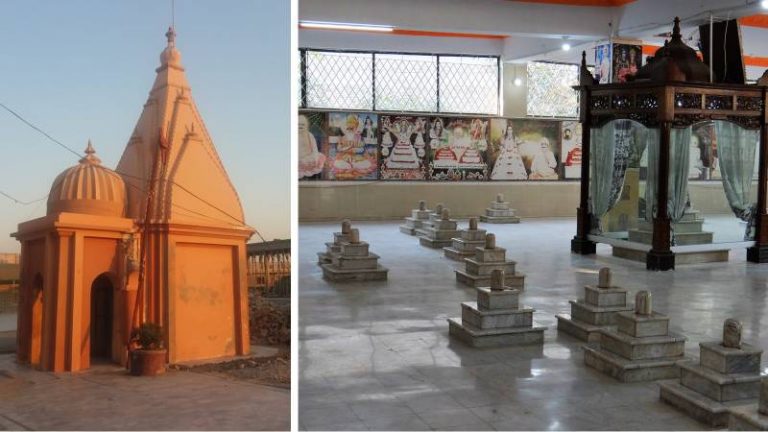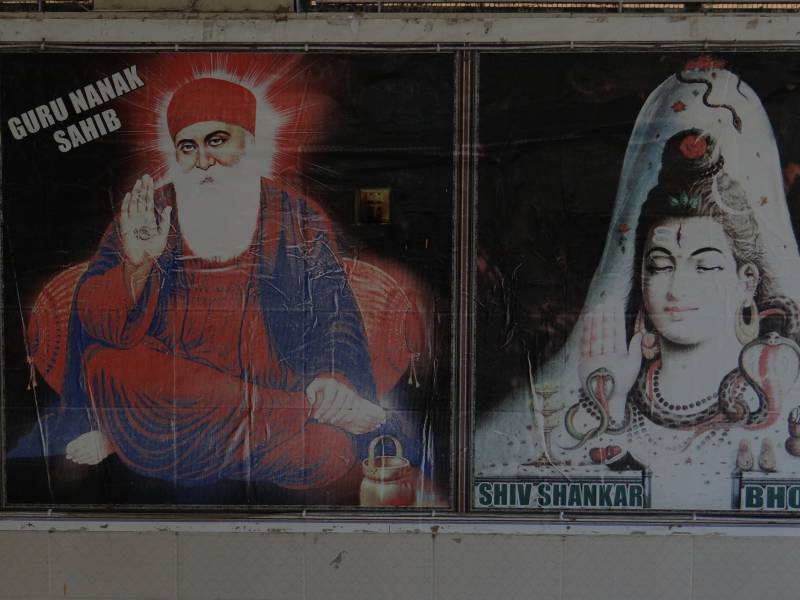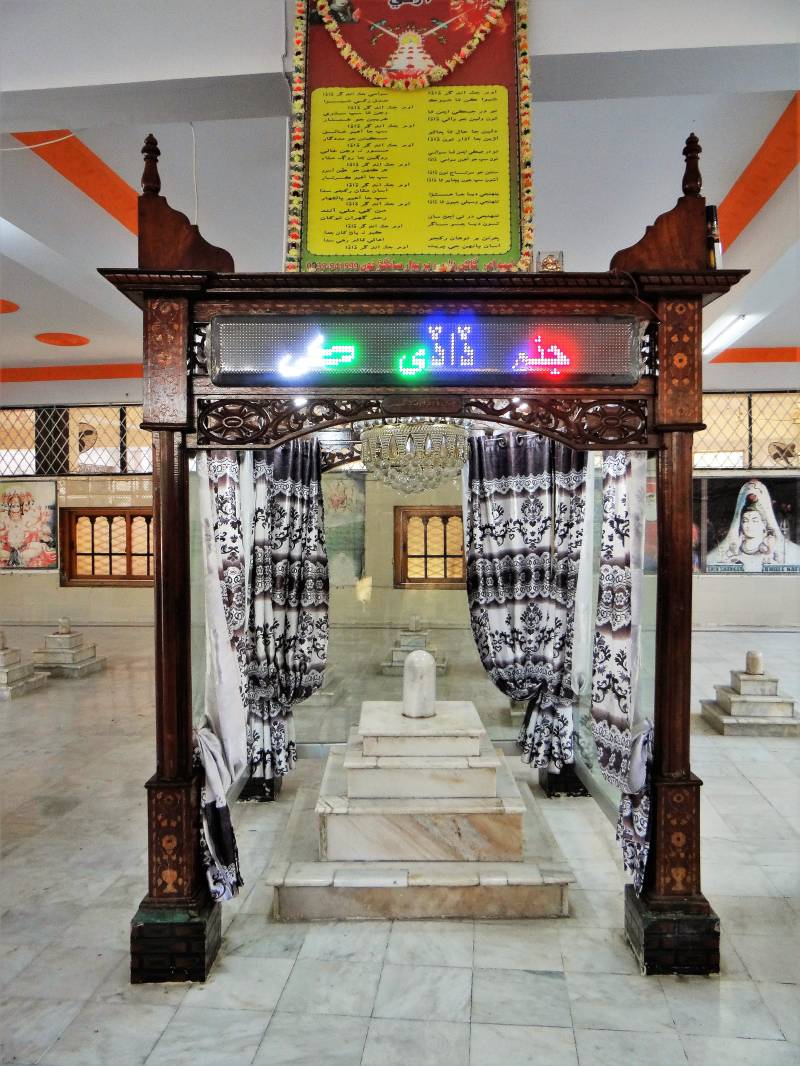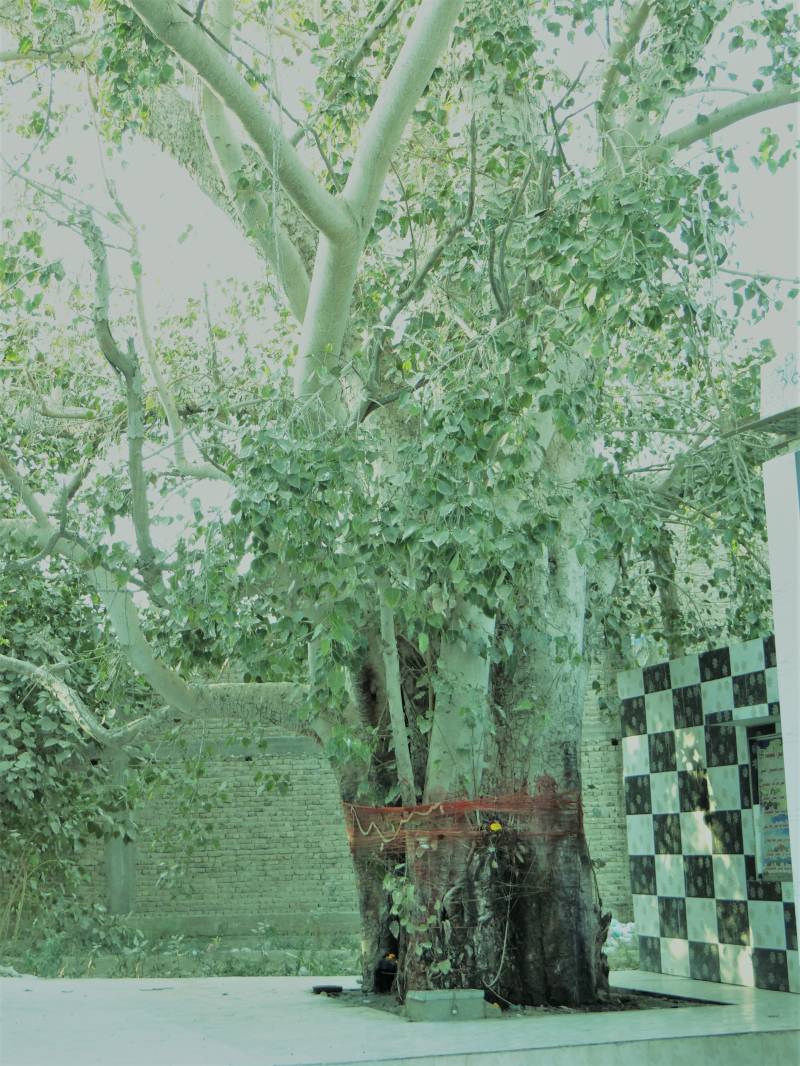
‘Sawai Shiyam Gir Ji Marrhi’ is one of the Hindu Heritage structures in Shahdadpur town of Sindh province of Pakistan
Zaffar Junejo
In earlier times, religious structures inclined towards mysticism and spirituality had some common characteristics, one of which was their existence at a distance from human settlements. This same characteristic could be witnessed in many Marris, Ashtans and Khanqahs located near mountains, forests, riverbanks or on the outskirts of human settlements. However, nowadays, most of them seem to be a part of or adjacent to particular villages, towns, or cities. This is also true of Shahdadpur’s Sawai Shiaym Gir Ji Marrhi.
But before a discussion on the details of the Marrhi, it seems appropriate to introduce Shahdadpur town to the readers. It is currently a major town in the Sanghar district of Sindh. It is situated approximately 24 kilometres from Hala and roughly 64 kilometres of Hyderabad city. According to Mirza Qaleech Baig’s famous book Qadeem Sindh – Un Ja Mashhoor Shaher Aen Manno (Ancient Sindh’s Famous Cities and Peoples), Shahdadpur was established by Mir Shahdad Khan during the reign of Mian Yar Muhammad Khan Kalhoro. Mir Shahdad Khan cleared jungles, cultivated lands, provided irrigated water and reduced crime in the area. Mirza further adds that in 1781, after the murder of Mir Bijar Khan, Mir Abdullah and Mir Fateh Khan Talpurs abandoned the town. Another primary source, Albert William Hughes’ Gazetteer of Sindh (1874), provides substantial information about the town. Hughes states that the total population of Shahdadpur was 2006, with 756 Muslims and 1,250 Hindus. He mentions that the settlement is known as an abode of oil-seed crop cultivators and oil processors. Hughes also highlights that one of the famous persons of the town was Gosai Dharamgir.
I believe this introduction provides sufficient information about the town and permits this scribe to write about Sawai Shiyam Gir Ji Marrhi or Shiyam Gir Ji Marhi. I contacted Ali Nawaz Nizamani and requested assistance in finding a resource person for consultation. After a few days, Ali Nawaz Nizamani informed that he has contacted Mr. Lal, who is a suitable person to be interviewed regarding the Marrhi.
 The next day, I travelled from Hyderabad to Shahdadpur, picking up Ali Nawaz from his village, Baqar Nizamani and driving to Shahdadpur. We met Lal at his medical store. Ali Nawaz introduced me to him. I explained the purpose of my visit, but he suggested that he could spare sometime in the evening. Nevertheless, we decided to utilise that time to have interviews with journalists and primary teachers of Shahdadpur’s Primary School. Thus, we eventually visited the press club and the primary school.
The next day, I travelled from Hyderabad to Shahdadpur, picking up Ali Nawaz from his village, Baqar Nizamani and driving to Shahdadpur. We met Lal at his medical store. Ali Nawaz introduced me to him. I explained the purpose of my visit, but he suggested that he could spare sometime in the evening. Nevertheless, we decided to utilise that time to have interviews with journalists and primary teachers of Shahdadpur’s Primary School. Thus, we eventually visited the press club and the primary school.
At the press club, we learned from the journalists that during the time of the Babri Masjid incident, the assistant commissioner instigated some fanatics, many of whom were members of the MQM, to burn the Marrhi. However, the local people foiled the attempt, although some religious books and material were burned. We then proceeded to the primary school, where the headmaster warmly welcomed us. As I sipped my tea, I glanced at the notice boards, charts and sheets hanging on the walls. Suddenly, I noticed a board displaying the names of the school’s headmasters. It confirmed Huggs’s impression that Shahdadpur was a predominantly Hindu town. Afterward, we visited the town’s library, which was clean and well-maintained. We had a discussion with the librarian, who informed us that it is a reference library. Sadly, he mentioned that the number of readers had decreased over time, posing a threat to the library’s survival.
 Later, we met with Lal, who was one of the committee members responsible for taking care of the Marrhi. He explained that long ago, the Shiyam Gir Marrhi was considered a neighborhood of the town or an outer post. However, it is now part of the town, although it still exists on the outskirts of present-day Shahdadpur. Lal told us that the Marrhi has two adjacent sacred places (temples): one dedicated to Durga Devi and the other to the temple.
Later, we met with Lal, who was one of the committee members responsible for taking care of the Marrhi. He explained that long ago, the Shiyam Gir Marrhi was considered a neighborhood of the town or an outer post. However, it is now part of the town, although it still exists on the outskirts of present-day Shahdadpur. Lal told us that the Marrhi has two adjacent sacred places (temples): one dedicated to Durga Devi and the other to the temple.
He led us through some zigzagging streets, some wide and clean, and others narrow and dirty. Along the way, I asked a person selling children’s edible items at a neighborhood crossing about the difference in cleanliness of various neighborhoods. Indifferently, he replied that the clean ones belong to Diwan Paro, while the dirty ones are of Muslims.
Hastily catching up to Lal, who was engrossed in conversation with Ali Nawaz Nizamani, I listened as he said, “All religions have the liberty to worship at any place, whether it be a mosque, temple, home, by the bank of a river, under a tree, or in the forest, through dance or music. Likewise, all religions have some common words for worship. This is true for Hindus as well.” I joined in and Lal looked at me, welcomed me with a smile. He continued, stating that Puja takes on many forms, such as offering homage, giving thanks, praying, performing penance and contemplating the divine. Lal further explained that Puja can be performed individually or as a group, without any prescribed time.
After entering one of the sacred parts of the Marrhi, we respectfully removed our shoes and stepped into a larger room. Lal continued to explain that at the Marrhi, one could perform Puja several times a day or at specific times of the day. However, according to the Sindhi calendar one of the important days for Puja was Norateri. It is celebrated across India but with different customs and rituals. Lal drew a parallel to the Kerala celebration of Noratei, where children are introduced to the native language and the stages of learning. He went on to mention that Norateri is celebrated at the Marrhi every year and it is one of the main events.
As we continued our conversation, I noticed framed photos displaying religious sayings, posters and a significant number of pictures of Gir Sahibans or the successors of the Marrhi. Curious about the number of present Girs since its inception, I asked Lal. He confidently replied that there have been seventeen Girs so far. I requested him to provide their names and their timelines and if he didn’t know a name, he could leave it blank or X will be mentioned instead of names. After some thought, Lal recalled the following names: 1) Goswami Shiyam Gir; 2) Goswami Mangal Gir; 3) Maan Gir; 4) Birham Gir; 5) Lal Gir; 6) Daya Gir; 7) Goswai Dharam Gir (1876); 8) Kalyan Gir; 9) Ram Gir; 10) Shanbhu Gir; 11) Vasdev Gir; 12) X; 13) Swami Kalyan Gir Sahib; 14) X; 15) X; 16) Poj Swami Vasdev Gir Sahib; and 17) Swami Mohan Gir Sahib. The mention of Sahib at the end of the names of Girs intrigued me and Lal explained that it is a new post-partition addition. It may have been an attempt to align with the mainstream or the influential Sindhi Sikh community, where equal importance is given to the Bhagavad Gita and Guru Granth Sahib.
 Moving on, Lal led us to another part of the Marrhi, a temple. I asked Lal about the origin of Sawai Shiyam Gir; he explained that it is believed that his abode was the Abu Mountain in Rajasthan, India. Before leaving Abu Mountain, he sought permission from his spiritual teacher or Satguru. He then travelled to different parts of India and eventually settled in Shahdadpur, Sindh. He lit a fire outside the town and lived there alongside a Pipil tree. Interrupting Lal’s narrative, I asked about the agricultural land of the Marrhi. He shared two stories about how the land was acquired. According to one story, one day the Amir of Sindh, likely the Talpur Amirs, returned from a hunting campaign and stopped at the fire site of Sawai Shiyam Gir. Sawai offered them water from his earthen pot and shared pieces of his loaf. The Amir was amazed that the loaf never ended and the water never ran out. Impressed, he donated a large chunk of land to Sawai Shiyam Gir. Another story dated back to the British era when an English officer challenged Sawai Shiyam Gir, betting that his mare was not faster than their train. Sawai accepted the challenge and on the appointed day, he and his mare arrived at the station, while the train also reached on time. The race began and Sawai’s mare reached Nawabshah Railway Station well ahead of the train, resulting in the English officer losing. In appreciation, the English officer granted some land to Swami Shiyam Gir.
Moving on, Lal led us to another part of the Marrhi, a temple. I asked Lal about the origin of Sawai Shiyam Gir; he explained that it is believed that his abode was the Abu Mountain in Rajasthan, India. Before leaving Abu Mountain, he sought permission from his spiritual teacher or Satguru. He then travelled to different parts of India and eventually settled in Shahdadpur, Sindh. He lit a fire outside the town and lived there alongside a Pipil tree. Interrupting Lal’s narrative, I asked about the agricultural land of the Marrhi. He shared two stories about how the land was acquired. According to one story, one day the Amir of Sindh, likely the Talpur Amirs, returned from a hunting campaign and stopped at the fire site of Sawai Shiyam Gir. Sawai offered them water from his earthen pot and shared pieces of his loaf. The Amir was amazed that the loaf never ended and the water never ran out. Impressed, he donated a large chunk of land to Sawai Shiyam Gir. Another story dated back to the British era when an English officer challenged Sawai Shiyam Gir, betting that his mare was not faster than their train. Sawai accepted the challenge and on the appointed day, he and his mare arrived at the station, while the train also reached on time. The race began and Sawai’s mare reached Nawabshah Railway Station well ahead of the train, resulting in the English officer losing. In appreciation, the English officer granted some land to Swami Shiyam Gir.
As we stood in the open yard of the temple, we observed an old well, an old temple’s building and a Pipal tree (though not too old, as it was planted after the 1947 Partition). We also met another caretaker responsible for the Gao Shala (cow shelter). He mentioned that they continue the old traditions of the Marrhi, maintaining the Pipil tree, continuously lighting the sacred fire and taking care of the Gao Shala. Before bidding farewell, I asked Lal about other myths or stories associated with the Marrhi. He shared a couple of stories.
Numerous stories have circulated about Girs captivating the imaginations of the Marrhi’s disciples. One particularly popular tale recounts how Kalyan Gir decided to embark on a pilgrimage to the holy city of Haridwar
Once, some disciples asked Sawai Shiyam Gir for permission to visit the Ganga Terath (pilgrimage to the Ganges). Instead, Sawai arranged for them to have a Ganga-Darshan (sight of the Ganges) at the Marrhi, where they saw the Ganga and purified themselves in its sacred waters. Another story involved Lal Gir. One night, some visitors ran out of liquor and Lal Gir was informed that only one lady had some left. When asked, she refused to share it. Suddenly, the empty pots of the Marrhi were filled with liquor. The lady hurried to the Marrhi and complained to Lal Gir that her pots had become empty. He told her to go back and she would find the pots filled and indeed, she discovered that what he had said was true. Lal also mentioned a story about Kalyan Gir, who fell victim to smallpox. He predicted his own death and entrusted his disciple Shankar Gir with the custodianship of the Marrhi before leaving this world. Shankar, with great humility, expressed that he had only nine years left to live. He dedicated those remaining years to Kalyan Gir. Astonishingly, the next day, his age seemed to regress and he passed away. Kalyan Gir then lived an additional nine years, generously granted by the remaining lifespan of his devoted disciple.
Over time, numerous stories have circulated about Girs captivating the imaginations of the Marrhi’s disciples. One particularly popular tale recounts how Kalyan Gir decided to embark on a pilgrimage to the holy city of Haridwar. Shankar earnestly requested to accompany him, but his plea was declined on the grounds that there would be no one to care for the Marrhi in his absence. Although disappointed, Shankar accepted the decision and proposed a remarkable proposition to Kalyan Gir. He assured him that during his sacred dip in the Ganges and the subsequent observance, Kalyan Gir would witness his presence. As Kalyan Gir immersed himself in the holy waters of the Ganges and resurfaced, he was surprised to find that Shankar Gir had also emerged from the water alongside him. Bewildered, Kalyan Gir questioned when he had arrived, to which Shankar calmly responded, ‘I had already foretold you that I would be there.’ He then requested immediate permission to return to the Marrhi. Upon reaching the sacred site, Shankar discovered a loaf of bread (mani) that had been left uncooked on the griddle.
Also read: A Tale of Abandoned Hindu Temple in Karachi
Another cherished story among the disciples of the Marrhi involves the extraordinary ability of Shankar Gir to revive the deceased. One day, a distraught woman wife of Naromal urgently sought out Shankar Gir, carrying the lifeless body of her son, Basarmal. She placed the boy’s body before Shankar and fervently implored him to bring him back to life. Shankar Gir sprinkled a few drops of water upon the lifeless form and miraculously, the body began to breathe once more.
As the shadows lengthened and the birds’ songs grew louder, Lal accompanied us to the main gate of the temple. Sensing that he had something more to share, I kindly prompted him to express his thoughts. Lal fell silent for a moment, contemplating his words and finally expressed a sentiment that resonated deeply. He revealed that until the 1980s, the inhabitants of the Marrhi as well as his community never considered themselves as Hindus. However, with the weakening of nationalist and progressive movements, a realization dawned upon them that they were indeed Hindus or a minority. Gradually, this realization took root and they began to feel an overwhelming sense of insecurity. Lal confided that any fanatical event in India or elsewhere in the world heightened their fears that their religious places might be desecrated or vandalized. We bid farewell to Lal, but the lingering sense of insecurity and helplessness was palpable. It struck a chord within me, emphasizing the importance of the deep-rooted anxieties experienced by citizens of the country.
Also read: Shiva Temple of Sann tells a tale of roots of Hinduism in Sindh
_____________________-
 Dr. Zaffar Junejo has a Ph.D in History from the University of Malaya. His areas of interest are post-colonial history, social history and peasants’ history. He may be reached at junejozi@gmail.com
Dr. Zaffar Junejo has a Ph.D in History from the University of Malaya. His areas of interest are post-colonial history, social history and peasants’ history. He may be reached at junejozi@gmail.com
Courtesy: Friday Times Lahore